Skip to main content
|
|||||||||||||||||||
|
|
|||||||||||||||||||
STATISTICAL BRIEF #515:
|
|||||||||||||||||||
| September 2018 | |||||||||||||||||||
|
Asako S. Moriya, PhD and G. Edward Miller, PhD |
|||||||||||||||||||
Highlights
|
|||||||||||||||||||
IntroductionCurrently in the United States, prescription opioids are commonly used to treat both chronic and acute pain. These drugs can help manage some types of pain, but due to serious risks of opioid use disorder and overdose—particularly with high dosages and long-term use—opioids are not recommended as the first-line treatment for most types of pain.1 Examining patterns of use of prescribed opioids can contribute to efforts to make appropriate use of these drugs.This Statistical Brief presents estimates from the 2015 and 2016 Medical Expenditure Panel Survey Household Component (MEPS-HC) of fills of prescriptions for opioid medications that are commonly used to treat pain. Only prescriptions purchased or obtained in an outpatient setting are included in these estimates. Prescription medicines administered in an inpatient setting or in a clinic or physician's office are excluded. The sample includes all elderly adults (ages 65 and older) in the U.S. civilian noninstitutionalized population. (Statistical Brief #516 presents estimates of opioid use for non-elderly adults ages 18 to 64.) We examine the average annual percentages of elderly adults in 2015–2016 with any opioid use (1 or more prescription fills during year) and with frequent opioid use, which we define as having 4 or more prescription fills or refills during the year.2 We present overall estimates for the full population of elderly adults and for subgroups defined by sex, race/ethnicity, poverty status, insurance coverage, perceived health status, Census region, and MSA status. All differences mentioned in the text are significant at the p<0.05 level, or better. Because of methodological and definitional differences, readers should use caution when comparing MEPS data with data from other sources. Details on the MEPS methodology and differences with other sources are included in the Definitions section of this Statistical Brief. |
|||||||||||||||||||
FindingsOverall and by sex In 2015–2016, an average annual total of 9.8 million elderly adults, or 19.3 percent of the 50.5 million elderly adults in the U.S. civilian noninstitutionalized population, filled at least 1 opioid prescription, and 3.6 million or 7.1 percent of elderly adults had 4 or more opioid prescription fills or refills during the year (figure 1). There was no statistically significant difference in the rate of any use, or the rate of frequent use, between elderly men and women. Race/Ethnicity Any use and frequent use of outpatient opioid prescriptions differed across some racial and ethnic groups (figure 2). In 2015–2016, non-Hispanic whites (20.2 percent) were more likely, on average, than Hispanics (16.3 percent) and individuals of other races (14.3 percent) to fill an opioid prescription at least once during the year. A similar pattern was observed for frequent use of opioid prescriptions as non-Hispanic whites (7.5 percent) were more likely to obtain 4 or more opioid prescription fills during the year than Hispanics (5.2 percent) and individuals of other races (5.1 percent). Poverty status The likelihood of any use and frequent use of outpatient prescription opioids tended to be higher among elderly adults with lower incomes (figure 3). On average in 2015–2016, elderly adults with low-incomes (22.5 percent) and middle incomes (20.3 percent) were more likely to fill at least 1 opioid prescription during the year than those with high incomes (16.9 percent). Further, elderly adults who were poor (9.5 percent), low income (11.3 percent), or middle income (6.8 percent), were all more likely than high-income elderly adults (4.5 percent) to obtain 4 or more opioid prescription fills during the year. The average annual rate of frequent opioid use was also higher for poor and low-income elderly adults than for the middle-income elderly. Insurance coverage In 2015–2016, elderly adults with Medicare and other public insurance (24.4 percent) were more likely, on average, to fill at least 1 opioid prescription than elderly adults with Medicare only (18.8 percent) or Medicare and private insurance (18.9 percent) (figure 4). Similarly, elderly adults with Medicare and other public insurance (11.2 percent) were more likely than those with Medicare only (7.6 percent) and Medicare and private insurance (6.1 percent) to have 4 or more opioid prescription fills during the year. Perceived health status Any use and frequent use of outpatient opioids increased in a step-by-step fashion across health status categories as perceived health declined (figure 5). In 2015–2016, the average annual percentage of elderly adults who filled at least 1 outpatient opioid prescription during the year increased as their level of perceived health declined from excellent (8.8 percent), to very good (13.1 percent), to good (22.4 percent), to fair (29.4 percent), and finally to poor (39.4 percent). Similarly, the average annual percentage of elderly adults who had 4 or more opioid prescription fills also increased as their reported health status declined (1.6 percent for excellent health, 3.0 percent for very good health, 8.0 percent for good health, 13.9 percent for fair health, and 21.8 percent for poor health). Census region In 2015–2016, elderly adults in the Northeast Census region were less likely, on average, to fill any opioid prescriptions (13.3 percent) or to have 4 or more opioid prescription fills (4.0 percent) than those in other Census regions (23.1 and 8.7 percent in the Midwest, 20.1 and 7.6 percent in the South, and 19.3 and 7.2 percent in the West) (figure 6). The average annual rate of any opioid use was also lower in the West (19.3 percent) than in the Midwest (23.1 percent). Metropolitan Statistical Area (MSA) status Elderly adults living in MSAs were less likely than those living in non-MSAs to fill any outpatient opioid prescriptions (18.2 versus 24.6 percent) and to obtain 4 or more opioid prescription fills during the year (6.2 versus 11.1 percent) (figure 7). |
|||||||||||||||||||
Data SourceThis Statistical Brief uses data from the 2015 and 2016 MEPS Full-Year Consolidated Data Files (HC-181 and HC-192) and non-public versions of the 2015 and 2016 Prescribed Medicines Files (HC-178A and HC-188A). |
|||||||||||||||||||
DefinitionsOpioidsIn this Statistical Brief, we examine outpatient prescription fills of opioids that are commonly used to treat pain. These opioids are identified using generic drug names for narcotic analgesics and narcotic analgesic combinations in the Multum Lexicon database from Cerner Multum, Inc. We identify slightly more opioids commonly used for pain than one would find in the MEPS public use files due to methods used to preserve the confidentiality of sample members. Opioids that are excluded from our analysis include respiratory agents, antitussives, and drugs commonly used in Medication Assisted Treatment. Opioid prescription fills We examine the percentage of elderly adults with any outpatient opioid prescription fills during the year ("any use") and the percentage with 4 or more fills or refills ("frequent use"). Acquisition of 4 fills or refills represents the 75th percentile of the distribution of prescription fills among all adults (elderly and non-elderly) with any fills during the year. MEPS estimates of opioid use may differ from estimates based on other data sources for several reasons. For example, MEPS and the Substance Abuse and Mental Health Services Administration's (SAMSHA) National Survey on Drug Use and Health (NSDUH) have substantial differences in methodologies and objectives. The NSDUH any use estimates comprise both prescribed use and misuse. Misuse includes taking medications for the feeling and any way the doctor did not prescribe. NSDUH respondents report use in inpatient, as well as outpatient, settings. Moreover, NSDUH includes targeted questions with show cards for specific drugs, is self-reported using audio computer assisted self-interviewing (ACASI), surveys persons ages 12 and older, and questions are asked based on a 12-month recall period. In contrast, MEPS includes only prescribed drugs purchased in outpatient settings. Prescription medicines administered in an inpatient setting or in a clinic or physician's office are excluded. MEPS data are household reported, and one respondent reports for the entire household. MEPS uses computer assisted personal interviewing (CAPI), and questions are asked using a recall period of 3–6 months. Finally, this Statistical Brief examines opioid use among adults ages 65 and older. Elderly adults For this Brief, elderly adults are individuals ages 65 and older. The age variable used to identify elderly adults is based on the sample person's age as of the end of the year. If data were not collected during a round because the sample person was out of scope (e.g., deceased or institutionalized), then age at the time of the previous round was used. Race/Ethnicity Classification by race/ethnicity was based on information reported for each family member. First, respondents were asked if the person's main national origin or ancestry was Puerto Rican; Cuban; Mexican, Mexican-American, or Chicano; other Latin American; or other Spanish. All persons whose main national origin or ancestry was reported in one of these Hispanic groups, regardless of racial background, were classified as Hispanic. All other persons were classified according to their reported race. For this analysis, the following classification by race and ethnicity was used: Hispanic, non-Hispanic black, non-Hispanic white, and non-Hispanic other. The other category includes American Indian, Alaska Native, Asian or Pacific Islander, other race, and multiple races. Poverty status Each sample person was classified according to the total annual income of his or her family. Possible sources of income included annual earnings from wages, salaries, bonuses, tips, and commissions; business and farm gains and losses; unemployment and Worker's Compensation; interest and dividends; alimony, child support, and other private cash transfers; private pensions, individual retirement account (IRA) withdrawals, Social Security, and Department of Veterans Affairs payments; Supplemental Security Income and cash welfare payments from public assistance, Aid to Families with Dependent Children, and Aid to Dependent Children; gains or losses from estates, trusts, partnerships, S corporations, rent, and royalties; and a small amount of "other" income. Poverty status is the ratio of family income to the corresponding federal poverty thresholds, which control for family size and age of the head of family. Categories are defined as follows:
The MEPS respondent was asked to rate the health of each person in the family at the time of the interview according to the following categories: excellent, very good, good, fair, and poor. For persons with missing health status in a round, the response for health status at the previous round was used, if available. A small percentage of persons (<1 percent) had a missing response for perceived health status. Census region The Census region variable is based on the location of the household at the end of the year. If missing, the most recent location available is used.
The Metropolitan Statistical Area (MSA) variable is based on the location of the household at the end of the year and reflects the most recent delineations of MSAs established by Office of Management and Budget (OMB). |
|||||||||||||||||||
About MEPS-HCThe Medical Expenditure Panel Survey Household Component (MEPS-HC) collects nationally representative data on health care use, expenditures, sources of payment, and insurance coverage for the U.S. civilian noninstitutionalized population. The MEPS-HC is cosponsored by the Agency for Healthcare Research and Quality (AHRQ) and the National Center for Health Statistics (NCHS). More information about the MEPS-HC can be found on the MEPS Web site at http://www.meps.ahrq.gov/. |
|||||||||||||||||||
ReferencesFor a detailed description of the MEPS-HC survey design, sample design, and methods used to minimize sources of nonsampling error, see the following publications:Cohen, J. Design and Methods of the Medical Expenditure Panel Survey Household Component. MEPS Methodology Report No. 1. AHCPR Pub. No. 97-0026. Rockville, MD: Agency for Health Care Policy and Research, 1997. https://meps.ahrq.gov/data_files/publications/mr1/mr1.shtml. Cohen, S. Sample Design of the 1996 Medical Expenditure Panel Survey Household Component. MEPS Methodology Report No. 2. AHCPR Pub. No. 97-0027. Rockville, MD: Agency for Health Care Policy and Research, 1997. https://meps.ahrq.gov/data_files/publications/mr2/mr2.shtml. |
|||||||||||||||||||
Suggested CitationMoriya, A.S. and Miller, G.E. Any Use and Frequent Use of Opioids among Elderly Adults in 2015–2016, by Socioeconomic Characteristics. September 2018. Statistical Brief #515. Agency for Healthcare Research and Quality, Rockville, MD. https://meps.ahrq.gov/data_files/publications/st515/stat515.shtml |
|||||||||||||||||||
|
AHRQ welcomes questions and comments from readers of this publication who are interested in obtaining more information about access, cost, use, financing, and quality of health care in the United States. We also invite you to tell us how you are using this Statistical Brief and other MEPS data and tools and to share suggestions on how MEPS products might be enhanced to further meet your needs. Please email us at MEPSProjectDirector@ahrq.hhs.gov or send a letter to the address below: Joel Cohen, PhD, Director Center for Financing, Access, and Cost Trends Agency for Healthcare Research and Quality 5600 Fishers Lane, Mailstop 07W41A Rockville, MD 20857 |
|||||||||||||||||||
|
1 U.S. Department of Health and Human Services, Centers for Disease Control and Prevention. CDC Guidelines for Prescribing Opioids for Chronic Pain. https://www.cdc.gov/drugoverdose/pdf/guidelines_at-a-glance-a.pdf 2 Acquisition of 4 fills or refills represents the 75th percentile of the distribution of prescription fills among all adults (elderly and non-elderly) with any fills during the year. |
|||||||||||||||||||
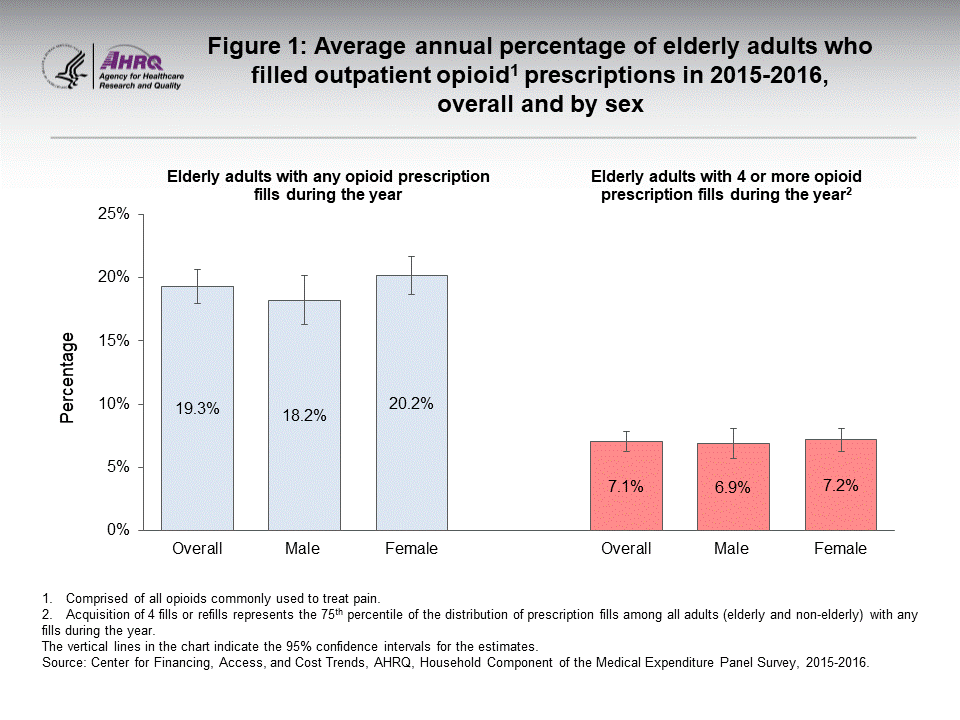 |
|||||||||||||||||||
|
|||||||||||||||||||
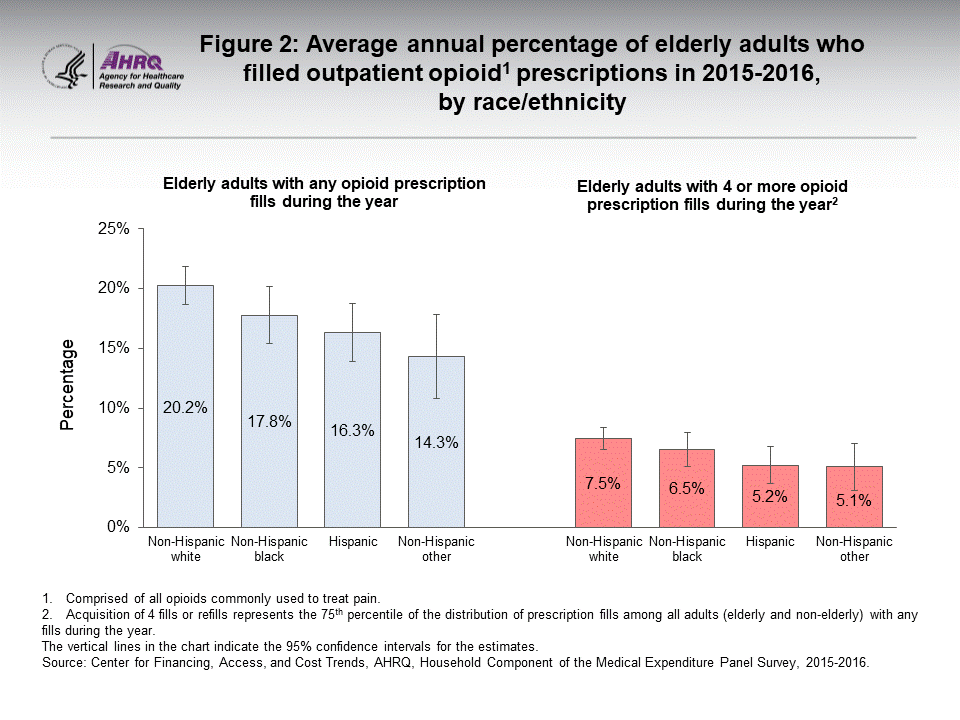 |
|||||||||||||||||||
|
|||||||||||||||||||
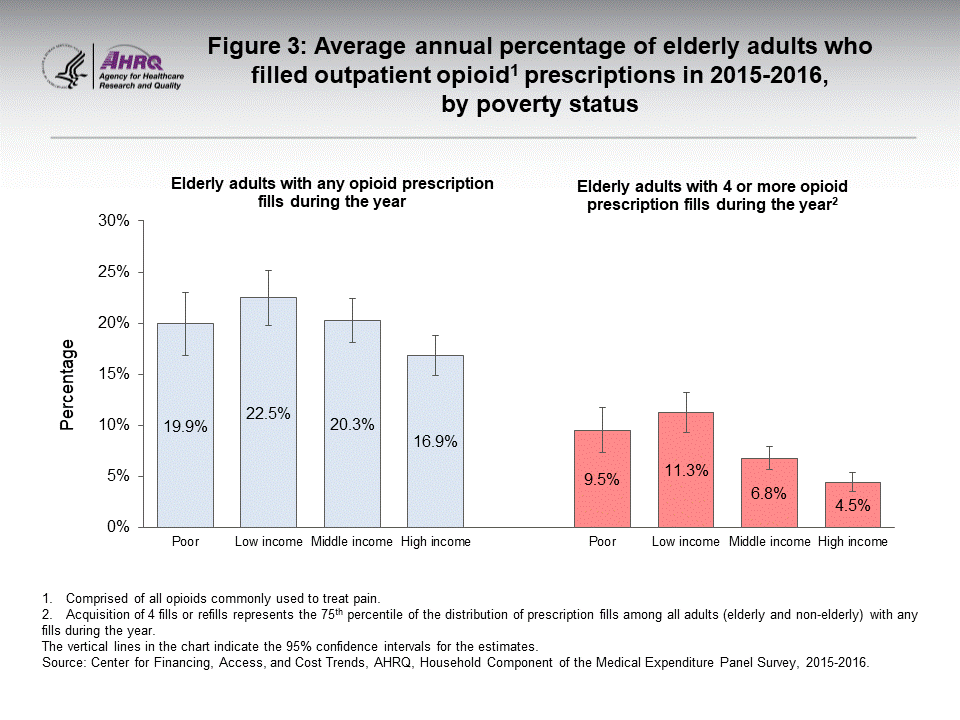 |
|||||||||||||||||||
|
|||||||||||||||||||
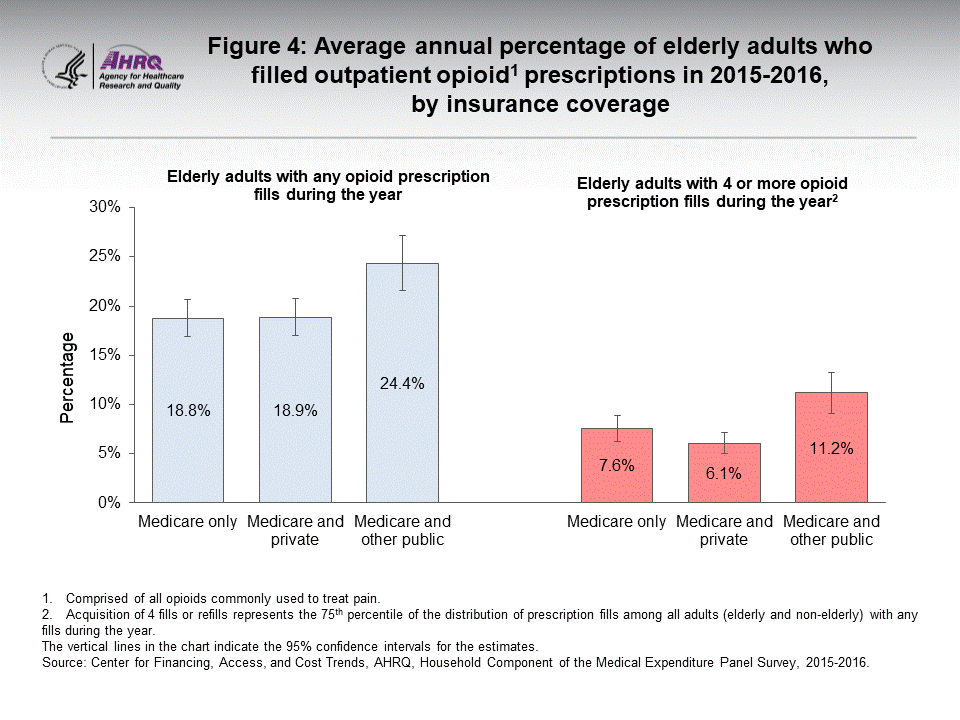 |
|||||||||||||||||||
|
|||||||||||||||||||
 |
|||||||||||||||||||
|
|||||||||||||||||||
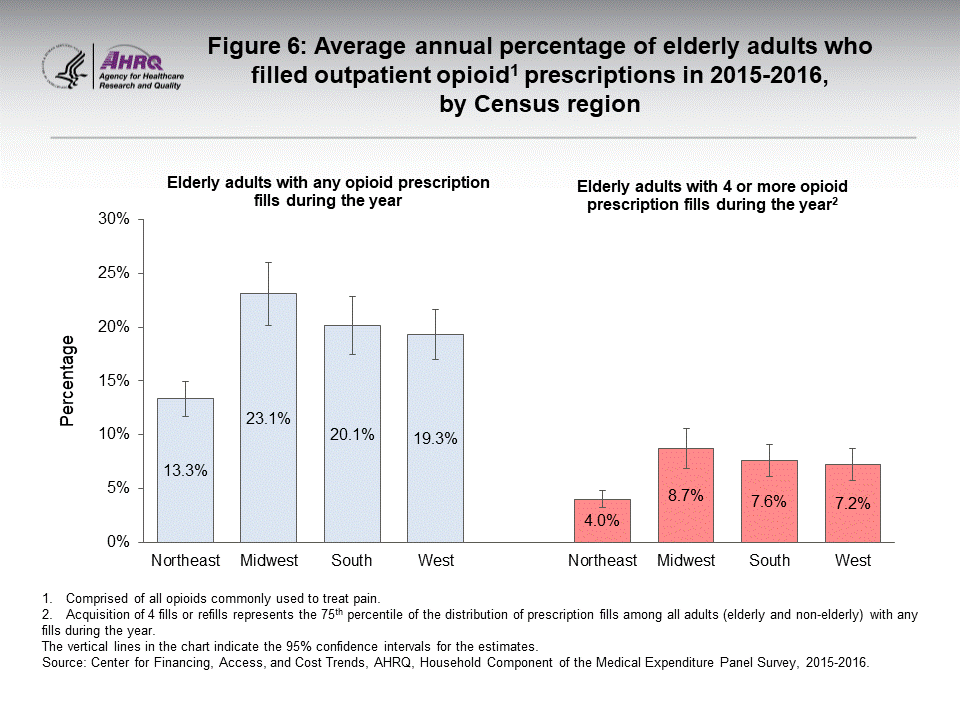 |
|||||||||||||||||||
|
|||||||||||||||||||
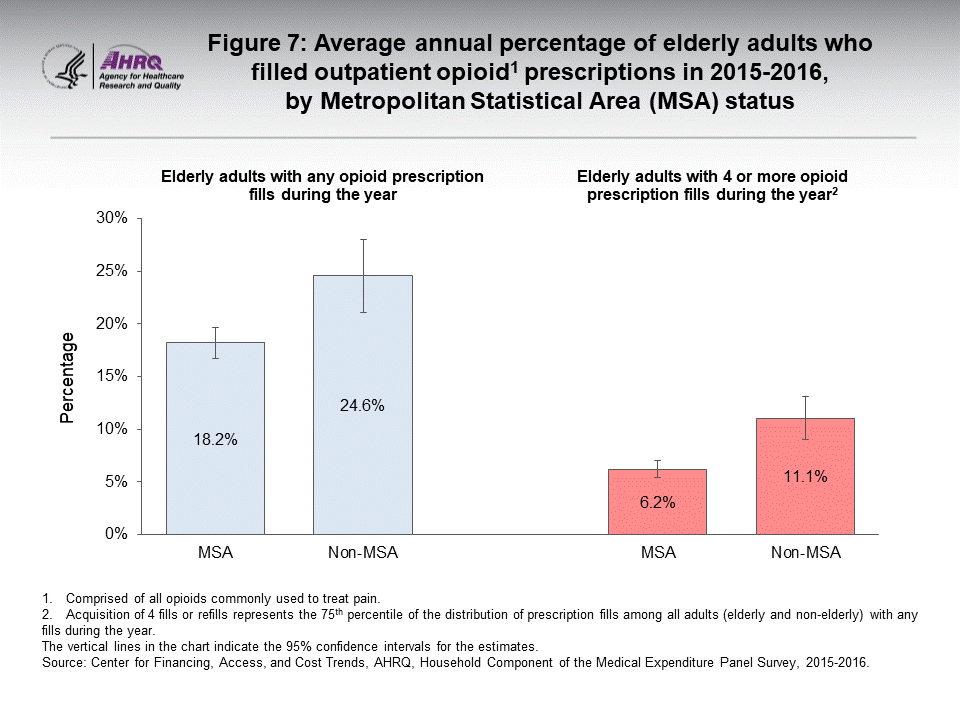 |
|||||||||||||||||||
|
|||||||||||||||||||
|
| |||||||||||||||||||



